SCI文章discussion部分写作技巧
discussion 和conclusions 的写法

discussion 和conclusions 的写法在写discussion和conclusions部分时,可以采用以下的写法:Discussion(讨论):1. 引言和背景:首先,提供该研究的背景信息和引入相关的文献,解释为什么这个研究是重要的。
2. 结果总结:概述和总结你的研究结果,以及任何观察到的模式或趋势。
确保提供足够详细的信息,以便读者能够理解你的研究。
3. 解释和讨论:对结果进行解释和讨论,解释你观察到的结果是否与研究问题一致。
分析数据,讨论任何发现的模式或趋势,探讨它们的可能原因,并比较结果与其他研究结果。
4. 支持的证据:引用和讨论过去的研究结果,以支持你的发现和观点。
还可以讨论你的研究与现有研究之间的相似之处和差异之处。
5. 局限性:讨论你研究的局限性,指出可能影响研究结果和可靠性的因素。
此外,提出可能的改进措施,以便未来能够解决这些局限性。
Conclusions(结论):1. 总结:总结你的研究结果并回答你的研究问题。
概述你的主要发现,强调它们的重要性。
2. 贡献:强调你的研究对该领域的贡献,并解释为什么这些贡献是重要的。
可以提及研究缺口,并说明你的研究如何填补这个缺口。
3. 实践意义:讨论你的研究结果对实践的影响,以及对决策制定者、专业人士或其他相关领域的影响。
说明研究结果的应用和潜在价值。
4. 建议:提出进一步研究的建议,以便扩展你的研究结果。
指出未来研究的方向和可能的扩大研究范围的途径。
总体上,discussion部分重点是对研究结果的解释和讨论,而conclusions部分则是对整个研究进行总结,并强调其贡献和实践意义。
如何撰写SCI论文的讨论与结论部分

如何撰写SCI论文的讨论与结论部分论文撰写是科研工作者必不可少的一部分工作,而SCI论文作为国际上最重要的学术期刊之一,对于科研人员来说具有极高的权威性。
讨论与结论部分是SCI论文中至关重要的一部分,它不仅可以总结研究结果,还可以提出启示和展望未来的研究方向。
本文将探讨如何撰写SCI论文中的讨论与结论部分。
一、讨论部分的撰写讨论部分是SCI论文中最重要、最丰富的部分之一。
在讨论部分中,作者需要对研究结果进行逐一分析,解释实验现象,探讨背后的机制,并与其他研究进行比较和讨论。
1. 对实验结果的解释:在讨论部分中,首先需要对实验结果进行全面、客观的解释。
明确实验结果的意义和价值,并说明其与前人研究的联系。
2. 提供证据支持:在进行讨论的过程中,作者应该提供充分的证据来支持自己的观点。
可以引用自己的实验数据,或者引用其他研究的结果来支持自己的观点,这样可以增加自己的说服力。
3. 分析不足之处:在讨论部分中,也需要分析研究中的不足之处。
例如,实验中存在的一些误差,方法的局限性等。
对这些问题进行客观分析,并提出改进的建议。
4. 与前人研究的比较:在撰写讨论部分时,也应该与前人的研究进行比较。
可以指出与前人研究结果的一致性或差异性,并解释其中的原因。
这样可以凸显自己的研究成果的独特性。
二、结论部分的撰写结论部分是SCI论文中总结与展望的部分,需要准确地概括研究的主要结果,并展望未来的研究方向。
1. 简明扼要地总结研究结果:结论部分需要简明扼要地总结研究的主要结果。
动作语态和简洁的句式应当使用,以提高可读性。
2. 给予研究成果应有的评价:结论部分还需要对研究成果进行客观的评价。
可以指出研究的创新性、重要性以及局限性。
这样可以提高论文的可信度和说服力。
3. 提出未来的研究方向:最后,结论部分需要展望未来的研究方向。
可以根据研究的局限性和不足之处提出改进的建议,并指出未来可能的研究方向,以便为后续研究提供启示。
总之,撰写SCI论文的讨论与结论部分需要考虑各方面的因素。
论文中最难写的是Discussion?教你如何轻松应对
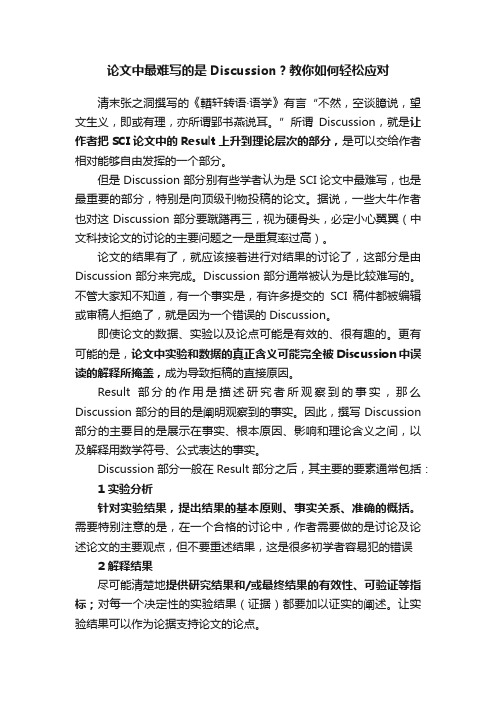
论文中最难写的是Discussion?教你如何轻松应对清末张之洞撰写的《輶轩转语·语学》有言“不然,空谈臆说,望文生义,即或有理,亦所谓郢书燕说耳。
”所谓Discussion,就是让作者把SCI论文中的Result上升到理论层次的部分,是可以交给作者相对能够自由发挥的一个部分。
但是Discussion部分别有些学者认为是SCI论文中最难写,也是最重要的部分,特别是向顶级刊物投稿的论文。
据说,一些大牛作者也对这Discussion部分要蹴躇再三,视为硬骨头,必定小心翼翼(中文科技论文的讨论的主要问题之一是重复率过高)。
论文的结果有了,就应该接着进行对结果的讨论了,这部分是由Discussion部分来完成。
Discussion部分通常被认为是比较难写的。
不管大家知不知道,有一个事实是,有许多提交的SCI稿件都被编辑或审稿人拒绝了,就是因为一个错误的Discussion。
即使论文的数据、实验以及论点可能是有效的、很有趣的。
更有可能的是,论文中实验和数据的真正含义可能完全被Discussion中误读的解释所掩盖,成为导致拒稿的直接原因。
Result部分的作用是描述研究者所观察到的事实,那么Discussion部分的目的是阐明观察到的事实。
因此,撰写Discussion 部分的主要目的是展示在事实、根本原因、影响和理论含义之间,以及解释用数学符号、公式表达的事实。
Discussion部分一般在Result部分之后,其主要的要素通常包括:1 实验分析针对实验结果,提出结果的基本原则、事实关系、准确的概括。
需要特别注意的是,在一个合格的讨论中,作者需要做的是讨论及论述论文的主要观点,但不要重述结果,这是很多初学者容易犯的错误2 解释结果尽可能清楚地提供研究结果和/或最终结果的有效性、可验证等指标;对每一个决定性的实验结果(证据)都要加以证实的阐述。
让实验结果可以作为论据支持论文的论点。
3 阐述观点作者要给出对论文结果的判断、评价、分析,并展示你的结果和解释与以前出版的文献结果进行比较,是否一致(或相反)。
Meta分析SCI写作指南——Discussion
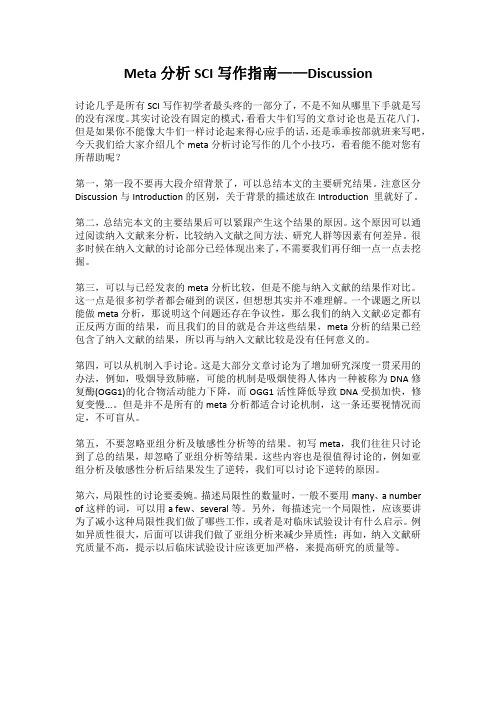
Meta分析SCI写作指南——Discussion讨论几乎是所有SCI写作初学者最头疼的一部分了,不是不知从哪里下手就是写的没有深度。
其实讨论没有固定的模式,看看大牛们写的文章讨论也是五花八门,但是如果你不能像大牛们一样讨论起来得心应手的话,还是乖乖按部就班来写吧,今天我们给大家介绍几个meta分析讨论写作的几个小技巧,看看能不能对您有所帮助呢?第一,第一段不要再大段介绍背景了,可以总结本文的主要研究结果。
注意区分Discussion与Introduction的区别,关于背景的描述放在Introduction里就好了。
第二,总结完本文的主要结果后可以紧跟产生这个结果的原因。
这个原因可以通过阅读纳入文献来分析,比较纳入文献之间方法、研究人群等因素有何差异。
很多时候在纳入文献的讨论部分已经体现出来了,不需要我们再仔细一点一点去挖掘。
第三,可以与已经发表的meta分析比较,但是不能与纳入文献的结果作对比。
这一点是很多初学者都会碰到的误区,但想想其实并不难理解。
一个课题之所以能做meta分析,那说明这个问题还存在争议性,那么我们的纳入文献必定都有正反两方面的结果,而且我们的目的就是合并这些结果,meta分析的结果已经包含了纳入文献的结果,所以再与纳入文献比较是没有任何意义的。
第四,可以从机制入手讨论。
这是大部分文章讨论为了增加研究深度一贯采用的办法,例如,吸烟导致肺癌,可能的机制是吸烟使得人体内一种被称为DNA修复酶(OGG1)的化合物活动能力下降,而OGG1活性降低导致DNA受损加快,修复变慢...。
但是并不是所有的meta分析都适合讨论机制,这一条还要视情况而定,不可盲从。
第五,不要忽略亚组分析及敏感性分析等的结果。
初写meta,我们往往只讨论到了总的结果,却忽略了亚组分析等结果。
这些内容也是很值得讨论的,例如亚组分析及敏感性分析后结果发生了逆转,我们可以讨论下逆转的原因。
第六,局限性的讨论要委婉。
Discussion是一篇SCI的重要部分-美辑编译
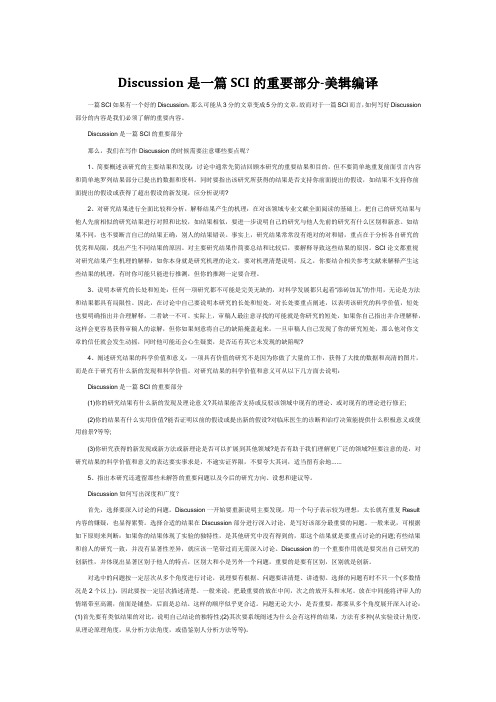
Discussion是一篇SCI的重要部分-美辑编译一篇SCI如果有一个好的Discussion,那么可能从3分的文章变成5分的文章。
故而对于一篇SCI而言,如何写好Discussion 部分的内容是我们必须了解的重要内容。
Discussion是一篇SCI的重要部分那么,我们在写作Discussion的时候需要注意哪些要点呢?1、简要概述该研究的主要结果和发现:讨论中通常先简洁回顾本研究的重要结果和目的,但不要简单地重复前面引言内容和简单地罗列结果部分已提出的数据和资料。
同时要指出该研究所获得的结果是否支持你前面提出的假设,如结果不支持你前面提出的假设或获得了超出假设的新发现,应分析说明?2、对研究结果进行全面比较和分析,解释结果产生的机理:在对该领域专业文献全面阅读的基础上,把自己的研究结果与他人先前相似的研究结果进行对照和比较,如结果相似,要进一步说明自己的研究与他人先前的研究有什么区别和新意。
如结果不同,也不要断言自已的结果正确,别人的结果错误。
事实上,研究结果常常没有绝对的对和错,重点在于分析各自研究的优劣和局限,找出产生不同结果的原因。
对主要研究结果作简要总结和比较后,要解释导致这些结果的原因。
SCI论文都重视对研究结果产生机理的解释,如你本身就是研究机理的论文,要对机理清楚说明,反之,你要结合相关参考文献来解释产生这些结果的机理,有时你可能只能进行推测,但你的推测一定要合理。
3、说明本研究的长处和短处:任何一项研究都不可能是完美无缺的,对科学发展都只起着“添砖加瓦”的作用,无论是方法和结果都具有局限性。
因此,在讨论中自己要说明本研究的长处和短处。
对长处要重点阐述,以表明该研究的科学价值,短处也要明确指出并合理解释,二者缺一不可。
实际上,审稿人最注意寻找的可能就是你研究的短处,如果你自己指出并合理解释,这样会更容易获得审稿人的谅解,但你如果刻意将自己的缺陷掩盖起来,一旦审稿人自己发现了你的研究短处,那么他对你文章的信任就会发生动摇,同时他可能还会心生疑窦,是否还有其它未发现的缺陷呢?4、阐述研究结果的科学价值和意义:一项具有价值的研究不是因为你做了大量的工作,获得了大批的数据和高清的图片,而是在于研究有什么新的发现和科学价值。
如何写sci英文论文的Discussion
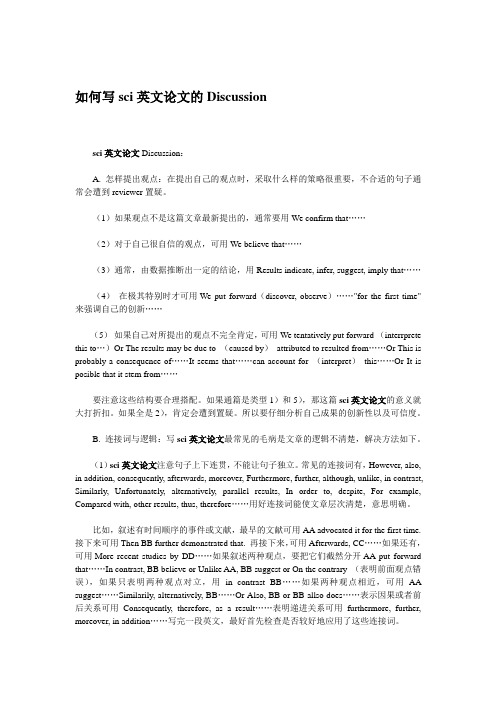
如何写sci英文论文的Discussionsci英文论文Discussion:A. 怎样提出观点:在提出自己的观点时,采取什么样的策略很重要,不合适的句子通常会遭到reviewer置疑。
(1)如果观点不是这篇文章最新提出的,通常要用We confirm that……(2)对于自己很自信的观点,可用We believe that……(3)通常,由数据推断出一定的结论,用Results indicate, infer, suggest, imply that……(4)在极其特别时才可用We put forward(discover, observe)……"for the first time"来强调自己的创新……(5)如果自己对所提出的观点不完全肯定,可用We tentatively put forward (interrprete this to…)Or The results may be due to (caused by)attributed to resulted from……Or This is probably a consequence of……It seems that……can account for (interpret)this……Or It is posible that it stem from……要注意这些结构要合理搭配。
如果通篇是类型1)和5),那这篇sci英文论文的意义就大打折扣。
如果全是2),肯定会遭到置疑。
所以要仔细分析自己成果的创新性以及可信度。
B. 连接词与逻辑:写sci英文论文最常见的毛病是文章的逻辑不清楚,解决方法如下。
(1)sci英文论文注意句子上下连贯,不能让句子独立。
常见的连接词有,However, also, in addition, consequently, afterwards, moreover, Furthermore, further, although, unlike, in contrast, Similarly, Unfortunately, alternatively, parallel results, In order to, despite, For example, Compared with, other results, thus, therefore……用好连接词能使文章层次清楚,意思明确。
如何撰写SCI论文的结果和讨论部分

如何撰写SCI论文的结果和讨论部分科学论文是学术界重要的交流和发表成果的方式之一。
在SCI论文中,结果和讨论部分是非常关键的一部分,它们承载着研究者的思考、发现和解读。
本文将介绍如何撰写SCI论文的结果和讨论部分。
一、结果部分结果部分是对实验、观察或模拟研究所得数据的陈述和分析,主要展示研究结果的客观性和详实性。
以下是撰写SCI论文结果部分的基本步骤和要点:1. 简明扼要地陈述结果:首先,应该按照实验或研究的不同方面,将结果划分为几个小节,每个小节应注明内容主题,并在开头简要陈述结果。
可以使用文字描述、表格、图表等形式来展示结果。
2. 图表的设计和使用:图表是结果部分重要的辅助工具,可以用来更直观地展示数据和趋势。
图表应具有清晰的标签和标题,保证读者能够准确理解图表内容。
同时,每个图表都应该有相应的文字说明,解释图表的含义和重要性。
3. 数据和统计分析:在结果部分中,需要详细描述实验或研究所得的数据,并进行适当的统计分析。
可以使用描述性统计、t检验、方差分析等方法来分析数据的特征和差异,并指出统计学上的显著性结果。
4. 结果的解读和讨论:不仅要简单地陈述结果,还需要对结果进行解释和讨论。
解释应基于实验设计、研究假设和背景知识等,并与相关文献进行比较和对照。
对于一些重要的结果,可以从不同角度进行解释,提供不同的思考和分析。
二、讨论部分讨论部分是对结果进行理解和解释的环节,也是论文展示作者科学思维和学术见解的重要部分。
以下是撰写SCI论文讨论部分的一些建议:1. 结果与研究问题的关系:讨论应始终围绕研究问题和目的展开。
对比结果与预期的一致性或差异,分析可能的原因,并提出合理的解释。
2. 结果的优点和局限性:在讨论部分中,需要客观评价结果的优点和局限性。
提出对结果的合理解释时,要注意承认可能的不确定性或假设的偏见,并提出未来研究的改进方向。
3. 结果与已有研究的联系:与讨论部分相关的一个重要方面是将自己的研究结果与已有文献和前人研究相联系。
meta分析的SCI写作模板—discussion

呕血整理,meta分析的SCI写作模板—discussion今天我们继续给大家带来《Meta分析的SCI写作模板》系列,今天给大家介绍的是文章的最后一部分-讨论部分-Discussion。
这部分的内容主要是先介绍我们的Meta分析的主要结果,解释一下产生主要结果的原因,与其它研究的异同点,本研究的必要性等,以及一些缺点等。
本文先介绍一下对结果的总体描述的表述,列举几个例子,让大家看一下本部分的写作方法。
①The overall goal of a meta-analysis is to combine the results of previous studies to arrive at a summary conclusion about a body of research.It is most useful in summarizing prior research when individual studies are too small to yield a valid conclusion.②In this study,we analyzed the associations between×××and×××using a meta-analysis to obtain a powerful conclusion.To the best of our knowledge,this is the first meta-analysis providing comprehensive insights into the effects of the×××and risk associated with×××.③Meta-analysis has been recognized as an effective method to answer a wide variety of clinical questions by summarizing and reviewing previously published, quantitative research.④Despite the fact that most of the trials had small sample sizes and poor methodological quality,analysis of the pooled data showed a consistently superior effect of×××combined with×××in terms of total effectiveness,when compared to the control groups.⑤The pooled data of×××(postoperative outcomes)suggest that×××was associated with shorter time to×××.Given that there were differences in×××(postoperative patient)management preferences and hospital discharge criteria, whether these potential benefits can be proved in future well designed RCTs is not known.。
英文学术文章 discussion
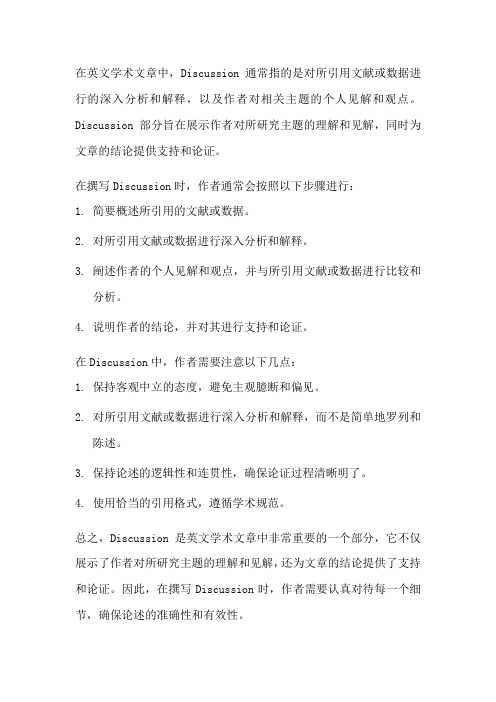
在英文学术文章中,Discussion通常指的是对所引用文献或数据进行的深入分析和解释,以及作者对相关主题的个人见解和观点。
Discussion部分旨在展示作者对所研究主题的理解和见解,同时为文章的结论提供支持和论证。
在撰写Discussion时,作者通常会按照以下步骤进行:
1.简要概述所引用的文献或数据。
2.对所引用文献或数据进行深入分析和解释。
3.阐述作者的个人见解和观点,并与所引用文献或数据进行比较和
分析。
4.说明作者的结论,并对其进行支持和论证。
在Discussion中,作者需要注意以下几点:
1.保持客观中立的态度,避免主观臆断和偏见。
2.对所引用文献或数据进行深入分析和解释,而不是简单地罗列和
陈述。
3.保持论述的逻辑性和连贯性,确保论证过程清晰明了。
4.使用恰当的引用格式,遵循学术规范。
总之,Discussion是英文学术文章中非常重要的一个部分,它不仅展示了作者对所研究主题的理解和见解,还为文章的结论提供了支持和论证。
因此,在撰写Discussion时,作者需要认真对待每一个细节,确保论述的准确性和有效性。
sci discussion部分字数

sci discussion部分字数
SCI(Science Citation Index)论文的 Discussion(讨论)部分是文章的重要组成部分,用于阐述研究结果的意义、解释结果与现有理论和研究之间的关系、指出研究的局限性以及提出未来的研究方向。
虽然没有具体的字数限制,但一般来说,SCI 论文的 Discussion 部分应该简洁明了,突出重点,避免冗长和啰嗦。
根据常见的学术写作规范和经验,SCI 论文的 Discussion 部分的字数通常在 500 到1500 字之间。
具体的字数取决于研究的复杂程度、结果的重要性以及作者需要阐述的内容。
然而,需要注意的是,字数并不是唯一的衡量标准,关键是要确保讨论部分内容充实、逻辑清晰、重点突出。
在撰写 Discussion 部分时,建议作者遵循以下原则:
1. 简洁明了:使用简洁的语言表达观点,避免过多的废话和重复。
2. 突出重点:突出研究的主要发现和贡献,以及它们对现有知识的影响。
3. 逻辑清晰:按照逻辑顺序组织讨论内容,使读者能够理解你的思路和推理过程。
4. 对比分析:将自己的研究结果与已有的相关研究进行对比,指出异同之处,并解释原因。
5. 未来展望:提出研究的局限性和未来的研究方向,为后续研究提供启示。
总之,SCI 论文的 Discussion 部分应该简洁明了、重点突出、逻辑清晰,避免冗长和啰嗦。
具体的字数应根据研究的复杂程度和需要阐述的内容来确定,一般在 500 到 1500 字之间。
几招教你写出令审稿人眼前一亮的Discussion
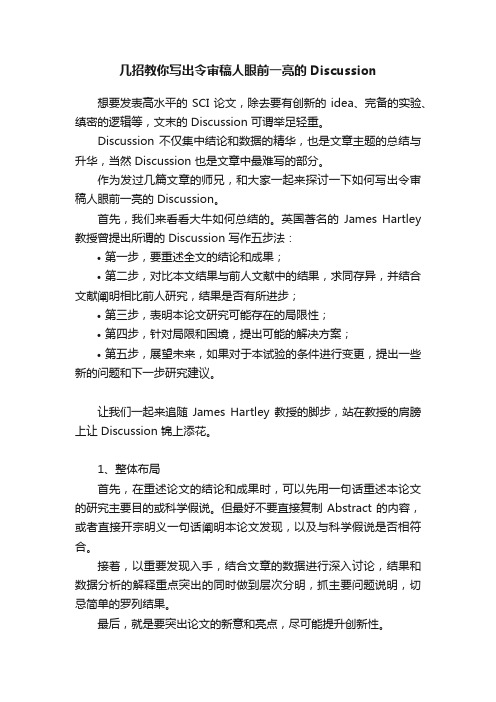
几招教你写出令审稿人眼前一亮的Discussion想要发表高水平的 SCI 论文,除去要有创新的 idea、完备的实验、缜密的逻辑等,文末的 Discussion 可谓举足轻重。
Discussion 不仅集中结论和数据的精华,也是文章主题的总结与升华,当然 Discussion 也是文章中最难写的部分。
作为发过几篇文章的师兄,和大家一起来探讨一下如何写出令审稿人眼前一亮的 Discussion。
首先,我们来看看大牛如何总结的。
英国著名的James Hartley 教授曾提出所谓的 Discussion 写作五步法:•第一步,要重述全文的结论和成果;•第二步,对比本文结果与前人文献中的结果,求同存异,并结合文献阐明相比前人研究,结果是否有所进步;•第三步,表明本论文研究可能存在的局限性;•第四步,针对局限和困境,提出可能的解决方案;•第五步,展望未来,如果对于本试验的条件进行变更,提出一些新的问题和下一步研究建议。
让我们一起来追随James Hartley 教授的脚步,站在教授的肩膀上让 Discussion 锦上添花。
1、整体布局首先,在重述论文的结论和成果时,可以先用一句话重述本论文的研究主要目的或科学假说。
但最好不要直接复制 Abstract 的内容,或者直接开宗明义一句话阐明本论文发现,以及与科学假说是否相符合。
接着,以重要发现入手,结合文章的数据进行深入讨论,结果和数据分析的解释重点突出的同时做到层次分明,抓主要问题说明,切忌简单的罗列结果。
最后,就是要突出论文的新意和亮点,尽可能提升创新性。
顶刊的 Discussion,图片来源:Nature Cell Biology2、详解操作我们以某医学顶刊上的一篇 Discussion 为例,来一起学习一下如何写出高分的 Discussion。
图片来源:文献截图图片来源:文献截图首先,前两句是:图片来源:文献截图Discussion 一开始重述本论文的研究主要目的或科学假说:「We have identified...within this treatment setting」。
18个段落快速写成第一篇SCI论文(二):Discussion讨论部分
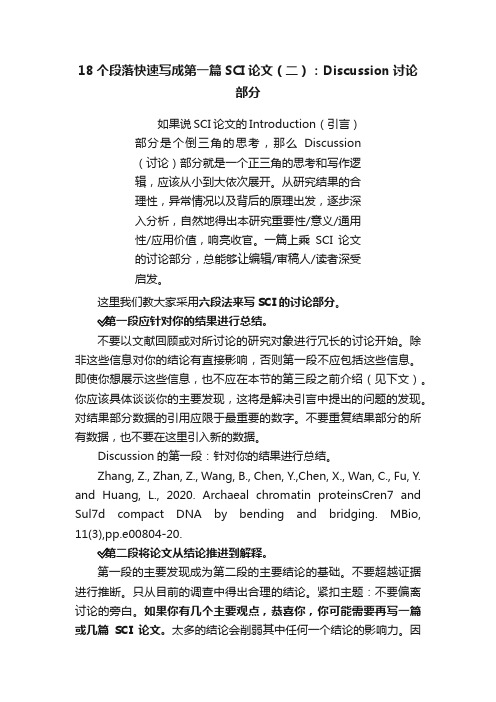
18个段落快速写成第一篇SCI论文(二):Discussion讨论部分如果说SCI论文的Introduction(引言)部分是个倒三角的思考,那么Discussion(讨论)部分就是一个正三角的思考和写作逻辑,应该从小到大依次展开。
从研究结果的合理性,异常情况以及背后的原理出发,逐步深入分析,自然地得出本研究重要性/意义/通用性/应用价值,响亮收官。
一篇上乘SCI论文的讨论部分,总能够让编辑/审稿人/读者深受启发。
这里我们教大家采用六段法来写SCI的讨论部分。
✅第一段应针对你的结果进行总结。
不要以文献回顾或对所讨论的研究对象进行冗长的讨论开始。
除非这些信息对你的结论有直接影响,否则第一段不应包括这些信息。
即使你想展示这些信息,也不应在本节的第三段之前介绍(见下文)。
你应该具体谈谈你的主要发现,这将是解决引言中提出的问题的发现。
对结果部分数据的引用应限于最重要的数字。
不要重复结果部分的所有数据,也不要在这里引入新的数据。
Discussion的第一段:针对你的结果进行总结。
Zhang, Z., Zhan, Z., Wang, B., Chen, Y.,Chen, X., Wan, C., Fu, Y. and Huang, L., 2020. Archaeal chromatin proteinsCren7 and Sul7d compact DNA by bending and bridging. MBio, 11(3),pp.e00804-20.✅第二段将论文从结论推进到解释。
第一段的主要发现成为第二段的主要结论的基础。
不要超越证据进行推断。
只从目前的调查中得出合理的结论。
紧扣主题:不要偏离讨论的旁白。
如果你有几个主要观点,恭喜你,你可能需要再写一篇或几篇SCI论文。
太多的结论会削弱其中任何一个结论的影响力。
因此,最好是写集中而紧凑的论文,而不是写一篇全面但分散的大作。
✅第三段应说明你的解释是否与其他研究人员的解释一致。
如何撰写SCI论文结果和讨论部分

如何撰写SCI论文结果和讨论部分SCI论文是科研工作者最为重要的成果之一,而其中的结果和讨论部分则是整个论文的核心内容之一。
撰写SCI论文的结果和讨论部分,不仅需要准确、客观地展示实验结果,还需要对结果作出深入的解读和分析。
下面将介绍如何撰写SCI论文的结果和讨论部分。
一、结果部分在SCI论文的结果部分,作者需要系统地、清晰地呈现实验的结果。
以下是撰写SCI论文结果部分的一些建议:1.准确呈现结果:作者需要将实验结果以可视化的形式展示出来,例如图表、表格等。
同时,结果部分也需要用文字简洁地描述结果,使读者可以直接了解实验结果。
2.按照逻辑顺序组织:作者需要按照实验的逻辑顺序来组织结果部分,将结果进行分析、对比、总结等,以便读者能够更好地理解研究的过程和结论。
3.精确描述统计分析:如果实验结果需要进行统计分析,作者需要明确描述所用的统计方法和工具,并给出相关的统计数据和显著性水平。
4.量化结果:作者需要将结果用数值化的方式进行描述,例如给出实验结果的平均值、标准差等指标,以便读者能够更准确地了解实验结果。
二、讨论部分在SCI论文的讨论部分,作者需要对结果进行详细的解读、分析和讨论。
以下是撰写SCI论文讨论部分的一些建议:1.解释结果:作者需要解释实验结果的含义和可能的原因,探讨研究中出现的现象,并与前人的研究结果进行比较和对照,以便读者能够更全面地理解实验结果。
2.提出假设:作者可以根据实验结果提出假设,并进行合理的推断和解释,同时需要结合已有的研究成果和理论知识进行论证。
3.讨论结果的局限性:作者需要客观地评估实验结果的限制和局限性,指出可能的误差来源和改进方法,使读者在理解实验结果的同时也了解到其局限性。
4.展望未来研究:作者可以提出实验结果的研究意义和未来研究的方向,为读者提供启示和思考的空间,同时也为后续的研究者提供参考。
总之,撰写SCI论文的结果和讨论部分需要准确、客观地展现实验结果,同时对结果进行深入的解读和分析。
如何写SCI论文的Discussion部分
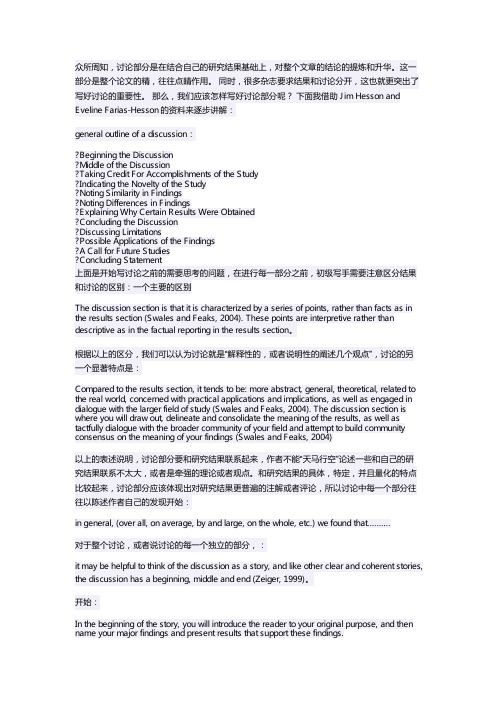
众所周知,讨论部分是在结合自己的研究结果基础上,对整个文章的结论的提炼和升华。
这一部分是整个论文的精,往往点睛作用。
同时,很多杂志要求结果和讨论分开,这也就更突出了写好讨论的重要性。
那么,我们应该怎样写好讨论部分呢?下面我借助Jim Hesson and Eveline Farias-Hesson的资料来逐步讲解:general outline of a discussion:?Beginning the Discussion?Middle of the Discussion?Taking Credit For Accomplishments of the Study?Indicating the Novelty of the Study?Noting Similarity in Findings?Noting Differences in Findings?Explaining Why Certain Results Were Obtained?Concluding the Discussion?Discussing Limitations?Possible Applications of the Findings?A Call for Future Studies?Concluding Statement上面是开始写讨论之前的需要思考的问题,在进行每一部分之前,初级写手需要注意区分结果和讨论的区别:一个主要的区别The discussion section is that it is characterized by a series of points, rather than facts as in the results section (Swales and Feaks, 2004). These points are interpretive rather than descriptive as in the factual reporting in the results section。
如何撰写SCI论文的讨论和结论部分

如何撰写SCI论文的讨论和结论部分撰写SCI论文的讨论和结论部分是整篇论文的关键部分,它不仅需要对实验结果进行全面和准确的解读,还要回答研究问题、总结研究结果,并提出展望和推广的建议。
本文将以SCI论文讨论和结论部分的写作要点为指导,为您提供详细的撰写建议。
一、讨论部分的撰写要点1.回答研究问题:讨论部分的首要任务是回答研究问题,对实验结果进行解读。
首先,回顾实验设计和方法,明确实验的可靠性;其次,分析实验结果,并结合前人研究结果进行比较;最后,提出自己的理解和解释。
2.解释实验结果:在解读实验结果时,应注重分析,提供可靠的数据支持和论据。
使用合适的图表将数据可视化,以帮助读者更好地理解结果。
解读实验结果时,应避免主观判断和夸大解读,应严谨客观,并提供充分的证据和解释。
3.探讨结果的限制和不确定性:讨论部分也需要对研究结果的限制和不确定性进行说明。
指出实验设计和方法的局限性,讨论可能影响结果的因素,并提出进一步研究的建议,以提高研究的可靠性和可重复性。
4.讨论与前人研究的关系:在讨论部分中,应与前人研究进行比较和对话,指出自己的研究相对于前人研究的创新之处,并讨论差异和共性。
可以结合前人研究的理论框架,对研究结果进行解释。
二、结论部分的撰写要点1.总结研究结果:结论部分需要对整篇论文的研究结果进行简洁明了的总结。
用清晰的语言回答研究问题,并指出实验结果的重要性和意义。
切忌冗长和废话,应精炼地概括。
2.明确发现与结论:结论部分应明确阐明研究的发现和结论,突出对学术和实践的贡献,同时也要对研究的局限性进行说明,不要过分夸大实际价值。
3.推广和应用展望:结论部分可以对研究结果的推广和应用进行展望,提出进一步研究的方向和建议。
对未来研究的挑战和问题进行探讨,引发读者的思考和讨论。
4.简明扼要:结论部分应精炼、简洁,主要通过几个重要的观点来回答研究问题,避免重复前文的内容。
不要提出新的观点或数据,结论部分要求简单明了,突出核心观点。
SCI论文中讨论部分的结论与总结技巧

SCI论文中讨论部分的结论与总结技巧SCI论文是学术界公认的高水平期刊,因此撰写一篇优秀的SCI论文是许多学者追求的目标。
在SCI论文中,讨论部分扮演着承上启下的重要角色,而结论与总结则是对整篇论文的归纳与概括,对于论文的质量和可读性至关重要。
本文将就SCI论文中讨论部分的结论与总结技巧进行探讨。
一、结论的撰写技巧在撰写SCI论文的结论时,应该满足以下几个基本要素:1. 简明扼要:结论应该精炼、简练,切忌过于冗长或赘述。
合理地使用段落和标点符号,将结论表达得简明扼要,并保持逻辑严密。
2. 针对研究问题:结论应围绕研究问题进行,对研究结果进行总结和回答。
在写结论时,可以参考前文的研究目的和研究方法,并结合实际研究结果对问题进行回答。
3. 指出创新性成果:结论中应突出强调研究的创新性成果,并指出这些成果在学术领域的意义和影响。
可以对成果的价值和应用前景进行一定的展望,从而引起读者的兴趣和重视。
4. 给出对未来研究的建议:结论部分可以对研究中存在的问题和不足进行分析,并提出对未来研究的建议。
这些建议可以是进一步深化研究、拓展实证范围、改进研究方法等,有助于引发更多学者对该研究领域的关注。
二、总结的撰写技巧在撰写SCI论文的总结时,应兼顾以下几个要点:1. 概括全文主要内容:总结部分应简要概括全文的主要内容,尽量避免与前文的论述内容重复。
可以用简洁的语言,提炼出论文的核心思想和研究成果。
2. 权衡利弊:总结过程中应对研究的优点和缺点进行权衡,客观地反映研究的现实局限性和可能存在的不足之处。
同时,还可以考虑在研究中的启示和教训,对研究的可改进性进行一定的思考。
3. 强调学术价值:总结部分可以强调论文对学术界的贡献和影响。
可以通过指出论文在理论、方法或应用等方面的创新之处,并阐述其在学术领域中的地位和重要性。
4. 总结研究意义和局限性:总结最后还应该总结研究的意义和局限性。
要清晰地指出论文的研究意义,说明论文的创造性成果,同时也不可避免地提及研究的局限性和待解决问题。
SCI文章discussion部分写作技巧

SCI⽂章discussion部分写作技巧Fourteen Steps to Writing an Effective Discussion SectionSan Francisco Edit/doc/1287658b6c85ec3a86c2c538.htmlimplications of your findings, and make suggestions for future research. Its main function is to answer the questions posed in the Introduction, explain how the results support the answers and, how the answers fit in with existing knowledge on the topic. The Discussion is considered the heart of the paper and usually requires several writing attempts.The organization of the Discussion is important. Before beginning you should try to develop an outline to organize your thoughts in a logical form. You can use a cluster map, an issue tree, numbering, or some other organizational structure. The steps listed below are intended to help you organize your thoughts. If you need additional help see our articles Eight Steps to Developing an Effective Manuscript Outline and Twelve Steps to Developing an Effective First Draft of your Manuscript at/doc/1287658b6c85ec3a86c2c538.html /newsletters.html.To make your message clear, the discussion should be kept as short as possible while clearly and fully stating, supporting, explaining, and defending your answers and discussing other important and directly relevant issues. Care must be taken to provide a commentary and not a reiteration of the results. Side issues should not be included, as these tend to obscure the message. No paper is perfect; the key is to help the reader determine what can be positively learned and what is more speculative. 1. Organize the Discussion from the specific to the general: your findings to the literature, to theory, to practice.2. Use the same key terms, the same verb tense (present tense), and the same point of view that you used when posing the questions in the Introduction.3. Begin by re-stating the hypothesis you were testing and answering the questionsposed in the introduction.4. Support the answers with the results. Address all the results relating to the questions, regardless of whether or not the findings were statistically significant.5. Describe the patterns, principles, and relationships shown by each majorfinding/result and put them in perspective. The sequencing of providing this information is important; first state the answer, then the relevant results before citing the work of others. If necessary, point the reader to a figure or table to enhance the “story”.6. Support your answers by explaining how your results relate to expectations and to the literature, clearly stating why they are acceptable and how they are consistent or fit in with previously published knowledge on the topic.7. Defend your answers, if necessary, by explaining both why your answer is satisfactory and why others are not. Only by giving both sides to the argument can you make your explanation convincing.8. Discuss and evaluate conflicting explanations of the results. This is the sign of a good discussion.9. Discuss any unexpected findings. When discussing an unexpected finding, begin the paragraph with the finding and then describe it.10. Identify potential limitations and weaknesses and comment on the relative importance of these to your interpretation of the results and how they may affect the validity of the findings. When identifying limitations and weaknesses, avoid using anapologetic tone.11. Summarize concisely the principal implications of the findings regardless of statistical significance.12. Provide recommendations (no more than two) for further research. Do not offer suggestions, which could have been easily addressed within the study, as this shows there has been inadequate examination and interpretation of the data.13. Explain how the results and conclusions of this study are important and how they influence our knowledge or understanding of the problem being examined.14. Discuss everything, but be concise, brief, and specific in your writing of the Discussion.。
原来Discussion也有写作套路!

原来Discussion也有写作套路!上个月,我们介绍了科技论文引言部分的写作套路(点此回顾),包括写作顺序和结构,同时提供了许多实用的写作模板,希望你阅读完之后能够独立撰写出逻辑清晰且符合科技论文规范要求的引言部分。
本月,我们以同样的方式继续和大家分享一下关于论文讨论部分的写作流程和常用模板,如果你正准备开始撰写SCI论文,那么绝对不容错过!讨论部分的常规写作顺序1、重新回顾一下论文之前的内容(如Introduction、Results 部分),简要地总结一些普遍的或关键的实验结果。
尽管你之前已经详细说明的主要的Results,因此类似于Abstract部分那样简单提及几句即可,这么做是为了更自然地过渡到对于你的实验结果的更深层次的解释和讨论。
2、阐述你的研究工作与当前研究领域有哪些关联性,将你的研究成果融入该领域的研究背景中。
你在引言部分已经作过文献综述,描绘了研究领域的现状,而此刻你要进一步告诉读者你的研究结果是如何影响、甚至改变了你的研究领域的现状。
这种关联性可以是与其它相关文献结果的比较来进行说明,如实验方法的不同、对已有结果进行新的论证、对同一问题得出截然相反的结论、发现一个全新的现象……3、讨论你的研究工作对该领域产生的贡献程度,提炼出论文可能带来的更深远的影响。
研究论文的目的不仅仅是简单地获得和描述结果,而是需要在现有知识背景下如何去理解这些结果,并对其含义进行合理的说明,如研究结果意味着什么?问题和结果之间有什么关系?你的结果与其它文献报导的是否一致?如果你的结果有点出乎意料,务必要尝试解释原因。
读者希望知道他们可以从你的论文中获取到哪些可靠的信息。
在Results部分你只需要描述清楚你得到了什么实验数据和结果,而Discussion部分的核心作用是与读者探讨它们究竟有哪些意义和作用。
4、重点强调你的研究存在哪些切合实际的应用潜力和前景,同时说明本研究在当前的局限性以及对未来可能的延续性研究的展望。
都说论文的Discussion部分很难写,那是因为你不知道这些技巧!
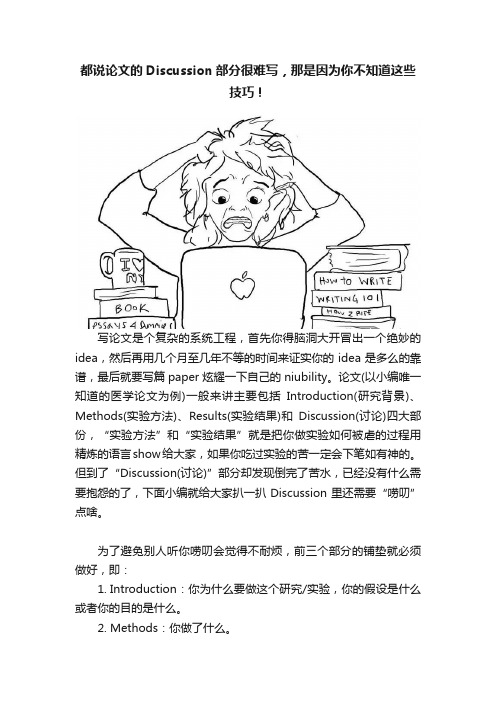
都说论文的Discussion部分很难写,那是因为你不知道这些技巧!写论文是个复杂的系统工程,首先你得脑洞大开冒出一个绝妙的idea,然后再用几个月至几年不等的时间来证实你的idea是多么的靠谱,最后就要写篇paper炫耀一下自己的niubility。
论文(以小编唯一知道的医学论文为例)一般来讲主要包括Introduction(研究背景)、Methods(实验方法)、Results(实验结果)和Discussion(讨论)四大部份,“实验方法”和“实验结果”就是把你做实验如何被虐的过程用精炼的语言show给大家,如果你吃过实验的苦一定会下笔如有神的。
但到了“Discussi on(讨论)”部分却发现倒完了苦水,已经没有什么需要抱怨的了,下面小编就给大家扒一扒Discussion里还需要“唠叨”点啥。
为了避免别人听你唠叨会觉得不耐烦,前三个部分的铺垫就必须做好,即:1.Introduction:你为什么要做这个研究/实验,你的假设是什么或者你的目的是什么。
2.Methods:你做了什么。
3.Results:你发现了什么。
接下来小编码的每一个字都要记清楚啦!总的来说Disscussion部分应该是一篇介绍你的研究重要性的短文。
你的研究结果意味着什么,它们与该领域已知的研究如何融为一体,它们对目前的科学观念以及临床实践有何影响,它们对未来的研究有何指导意义。
写Discussion的一个目的是为了确保读者对你的研究结果有个正确、准确的理解。
为了写好Discussion,文中应该包含以下内容:•在Discussion的开头部分直截了当的提出基于你实验结果的研究结论。
•阐释你的研究发现----这些实验结果的意义以及它们之间如何相互联系。
•指出你的研究发现是否与已有文献相一致,如果不一致请给出一个合理的解释。
•说明你的研究的创新性。
•承认研究存在的不足,和可能导致对该论文的批评建议(如果可以,可给出充分的、足以让让读者或者审稿人相信他们指出的问题其实根本不是问题)•描述出你的研究对填补知识空白的重要性。
- 1、下载文档前请自行甄别文档内容的完整性,平台不提供额外的编辑、内容补充、找答案等附加服务。
- 2、"仅部分预览"的文档,不可在线预览部分如存在完整性等问题,可反馈申请退款(可完整预览的文档不适用该条件!)。
- 3、如文档侵犯您的权益,请联系客服反馈,我们会尽快为您处理(人工客服工作时间:9:00-18:30)。
Fourteen Steps to Writing an Effective Discussion Section
San Francisco Edit
implications of your findings, and make suggestions for future research. Its main function is to answer the questions posed in the Introduction, explain how the results support the answers and, how the answers fit in with existing knowledge on the topic. The Discussion is considered the heart of the paper and usually requires several writing attempts.
The organization of the Discussion is important. Before beginning you should try to develop an outline to organize your thoughts in a logical form. You can use a cluster map, an issue tree, numbering, or some other organizational structure. The steps listed below are intended to help you organize your thoughts. If you need additional help see our articles Eight Steps to Developing an Effective Manuscript Outline and Twelve Steps to Developing an Effective First Draft of your Manuscript at
/newsletters.html.
To make your message clear, the discussion should be kept as short as possible while clearly and fully stating, supporting, explaining, and defending your answers and discussing other important and directly relevant issues. Care must be taken to provide a commentary and not a reiteration of the results. Side issues should not be included, as these tend to obscure the message. No paper is perfect; the key is to help the reader determine what can be positively learned and what is more speculative. 1. Organize the Discussion from the specific to the general: your findings to the literature, to theory, to practice.
2. Use the same key terms, the same verb tense (present tense), and the same point of view that you used when posing the questions in the Introduction.
3. Begin by re-stating the hypothesis you were testing and answering the questions
posed in the introduction.
4. Support the answers with the results. Address all the results relating to the questions, regardless of whether or not the findings were statistically significant.
5. Describe the patterns, principles, and relationships shown by each major
finding/result and put them in perspective. The sequencing of providing this information is important; first state the answer, then the relevant results before citing the work of others. If necessary, point the reader to a figure or table to enhance the “story”.
6. Support your answers by explaining how your results relate to expectations and to the literature, clearly stating why they are acceptable and how they are consistent or fit in with previously published knowledge on the topic.
7. Defend your answers, if necessary, by explaining both why your answer is satisfactory and why others are not. Only by giving both sides to the argument can you make your explanation convincing.
8. Discuss and evaluate conflicting explanations of the results. This is the sign of a good discussion.
9. Discuss any unexpected findings. When discussing an unexpected finding, begin the paragraph with the finding and then describe it.
10. Identify potential limitations and weaknesses and comment on the relative importance of these to your interpretation of the results and how they may affect the validity of the findings. When identifying limitations and weaknesses, avoid using an apologetic tone.
11. Summarize concisely the principal implications of the findings regardless of statistical significance.
12. Provide recommendations (no more than two) for further research. Do not offer suggestions, which could have been easily addressed within the study, as this shows there has been inadequate examination and interpretation of the data.
13. Explain how the results and conclusions of this study are important and how they influence our knowledge or understanding of the problem being examined.
14. Discuss everything, but be concise, brief, and specific in your writing of the Discussion.。
